
6 Important Tips to Showcase Your Technical Skills in the Portfolio
Mar 24, 2025 5 Min Read 10630 Views
(Last Updated)
Do you know what is the key item when applying for a job interview? Having a strong portfolio can be the key to landing your dream tech job.
But it will be quite confusing and daunting at the start. The first question that will come to your mind is, what is the right way to showcase the technical skills in the portfolio? In fact, studies show that 59% of hiring managers prefer to see a work portfolio over a traditional resume, yet 80% will spend less than three minutes reviewing it.
This means you have only a brief window to impress, so every element of your portfolio needs to count. That is why in this article, we’ll explore proven strategies from structuring your portfolio for clarity to highlighting your best work and beyond to ensure your technical expertise stands out. So, without further ado, let us get started!
Table of contents
- 6 Essential Tips To Showcase Your Technical Skills in the Portfolio
- Start With Clarity and Structure
- Highlight Key Projects (Quality Over Quantity)
- Demonstrate Problem-Solving with Storytelling
- Include Testimonials and Collaboration
- Use Multimedia to Showcase Your Work
- Share Your Learning Journey (Keep It Current)
- Conclusion:
- FAQs
- Why is it important to have a clear structure in my technical portfolio?
- Can I include group projects in my portfolio?
- How do I choose which testimonials to include in my portfolio?
- Can personal projects be included in my portfolio?
6 Essential Tips To Showcase Your Technical Skills in the Portfolio
When you start applying for companies, your portfolio speaks volumes of your skills and that is why it is mandatory to have a well-structured and outstanding portfolio. Below are 6 tips to make sure your portfolio stands out from the crowd:
1. Start With Clarity and Structure
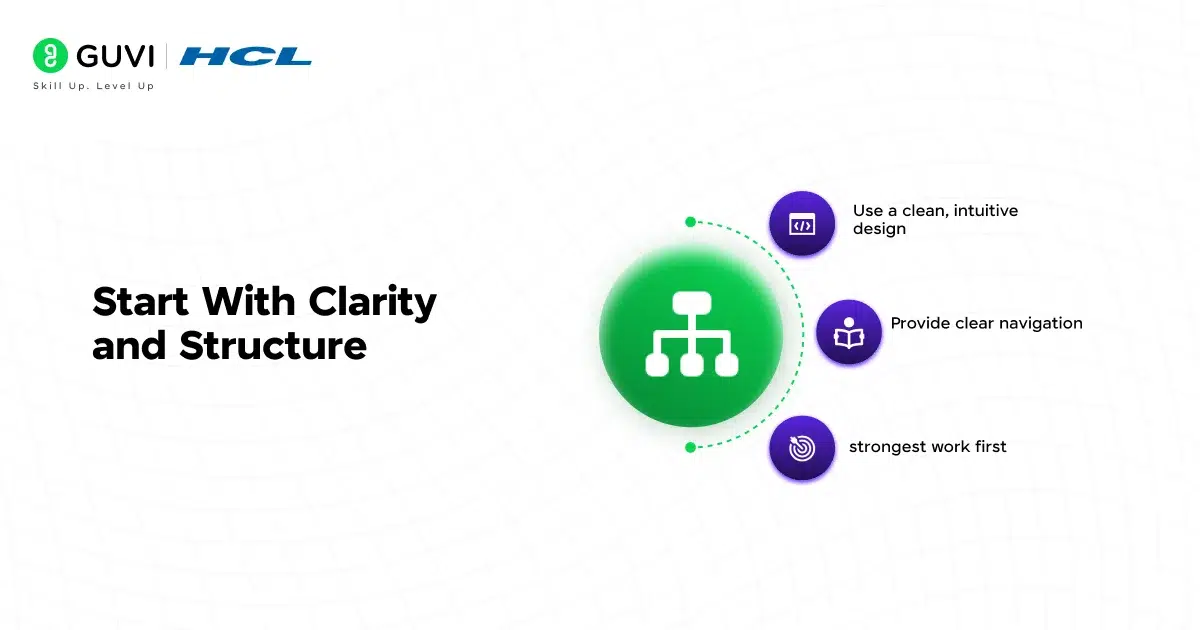
The first impression your portfolio gives is everything. When potential employers or clients land on your page, they should immediately understand who you are, what you do, and how to navigate your work.
A clear, well-organized structure helps guide the viewer and prevents them from feeling lost or overwhelmed.
a) Use a clean, intuitive design: A cohesive and organized design isn’t just about looking nice it’s about usability. Consistency in layout, navigation, and visuals is crucial for a positive user experience. Keep the layout simple and professional, with easy-to-read fonts. Make sure your site is also responsive (mobile-friendly) so it looks good on any device.
b) Provide clear navigation: Structure your portfolio into well-defined sections so visitors can find what they need quickly. Typical sections might include:
- About: A brief intro of who you are (your background or a summary).
- Projects: A showcase of your best projects (we’ll discuss how to pick these next).
- Skills: A list of programming languages, frameworks, tools, etc. that you know.
- Certifications/Achievements: Relevant certificates, awards, or accomplishments.
- Contact: How people can reach you (and maybe a downloadable resume).
c) Having an easy-to-use menu or homepage with these sections ensures that both technical and non-technical viewers can navigate with ease. In your Projects section, consider listing your strongest work first – you want to grab attention with something impressive right away.
A well-structured portfolio signals professionalism. It shows you care about the user experience, which in turn suggests you’ll bring that same thoughtfulness to your code and projects.
Learn More: How to Build a Developer Portfolio That Stands Out
2. Highlight Key Projects (Quality Over Quantity)
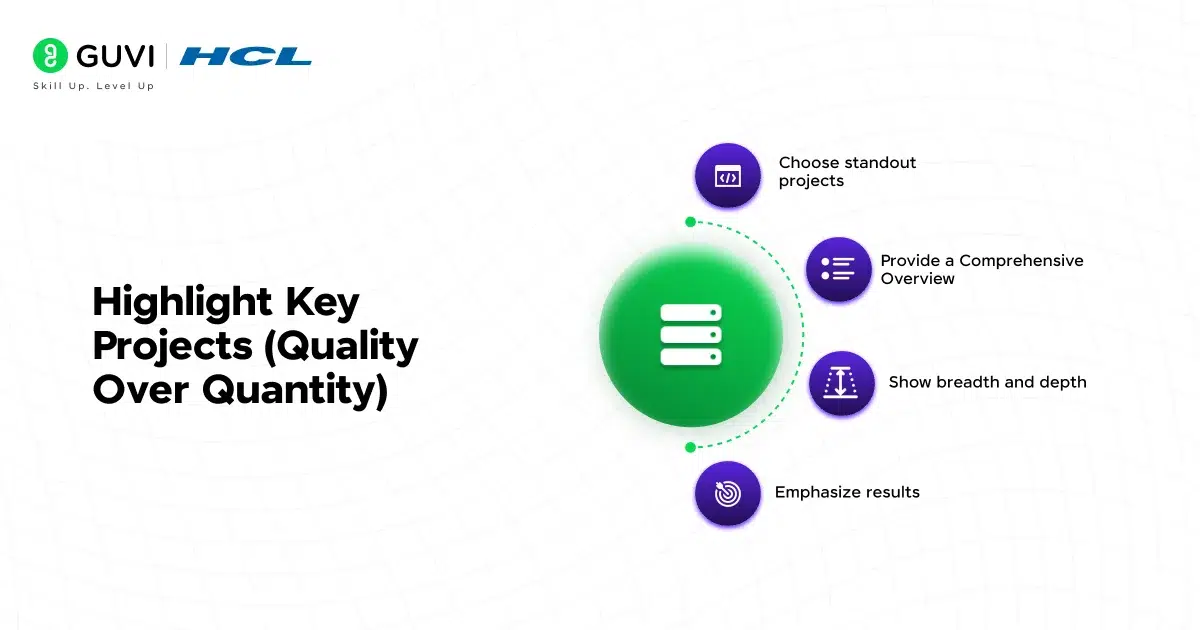
When it comes to showcasing projects, less is more. It’s tempting to include every project you’ve ever worked on, but a handful of well-chosen examples will have a greater impact.
Recruiters and clients typically have limited time, so you want to put forward work that best demonstrates your technical skills and accomplishments.
a) Choose standout projects: Focus on quality and relevance. Pick a few projects that best highlight your abilities, ideally ones that align with the type of roles you’re aiming for. For example, if you’re pursuing a web developer role, feature the web apps or websites you’ve built, not some unrelated class assignment.
b) Provide a Comprehensive Overview: For each project, provide a clear and concise description. Here’s what you should include:
- Project title and date
- Brief description
- Technologies used
- Challenges faced
- Results achieved
c) Show breadth and depth: Within your selected projects, try to show a range of skills. Perhaps one project emphasizes your front-end design talent, another showcases back-end logic or database work, and another might involve data analysis or an algorithmic challenge. This variety proves you’re versatile.
If you’re entry-level and only have academic or personal projects, that’s okay, just ensure they are polished and meaningful. If you’re experienced, you might include a significant project from a previous job alongside personal passion projects to show both professional impact and personal initiative.
d) Emphasize results: For each project, mention any tangible outcomes or metrics. Did your code improve an app’s performance or save resources? For example, “Implemented caching to cut load times by 50%” makes a stronger impression than just “Optimized the app.” Numbers and concrete results provide evidence of your effectiveness
Even on personal projects, you could note things like user adoption, star ratings (for apps), or what you learned (“built a chatbot that correctly answers 90% of user questions”).
Additionally, provide links to your project’s source code repository (e.g., a GitHub repo) or a live demo if available.
3. Demonstrate Problem-Solving with Storytelling
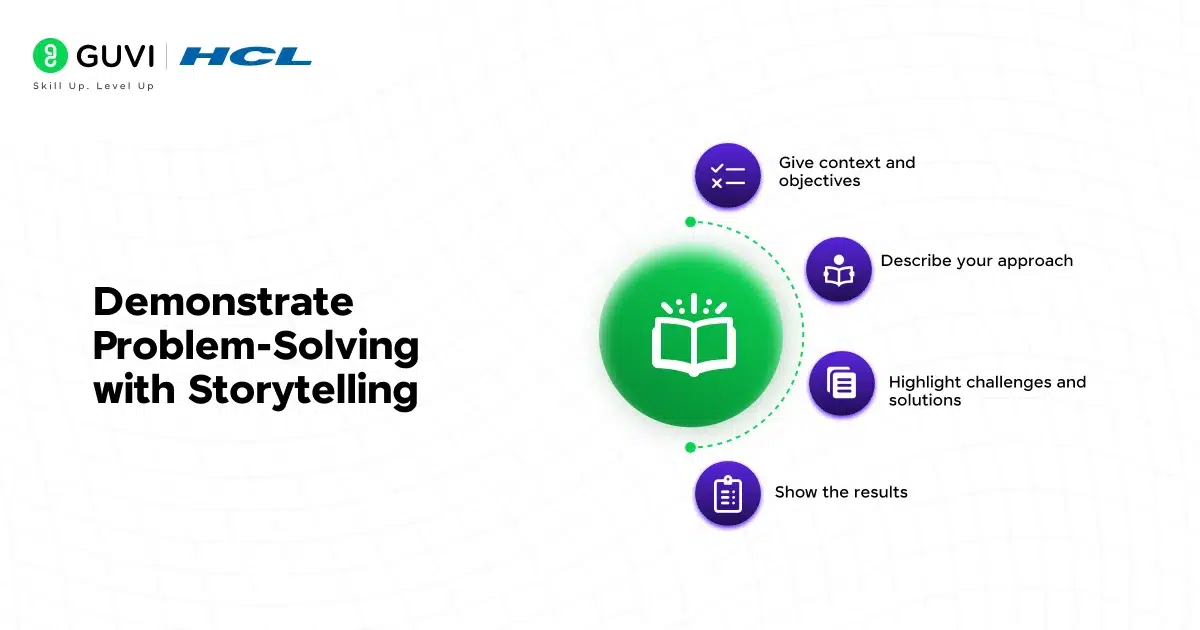
Employers aren’t just interested in what you built, rather they care about how you built it and the problems you solved along the way.
Use your portfolio to tell the story behind each project, highlighting your problem-solving skills and technical decision-making. This shows off your expertise and also your critical thinking and creativity in tackling challenges.
a) Give context and objectives: Briefly explain the goal or problem each project addresses. For example, instead of just naming a project “Chatbot App,” describe it as “Chatbot App – created to help users quickly find FAQs, reducing load on support staff.” This sets the stage and helps the reader appreciate why the project matters.
b) Describe your approach: Outline how you solved the problem. What technologies and techniques did you use, and why? What was your role if it was a team effort?
Keep it concise and avoid unnecessary jargon, the idea is to let the reader follow your thought process. For instance: “Built a machine learning model in Python using TensorFlow to classify images; tuned it to achieve 95% accuracy.”
c) Highlight challenges and solutions: If you encountered obstacles, mention how you overcame them. Perhaps you ran into scaling issues, tricky bugs, or had to learn a new tool on the fly.
Explaining such hurdles and your solutions demonstrates adaptability and problem-solving grit. For example: “Encountered memory leaks when processing data, so I used profiling tools to identify and fix the issue, reducing memory usage by 30%.”
d) Show the results: End the story with the outcome or impact. Did the project achieve its goals? Include any positive results, such as performance improvements, user growth, or a lesson learned. “As a result, the client’s process sped up by 2×,” or “The app was successfully used by 100+ employees.
This narrative approach (problem → solution → result) turns your projects into mini case studies rather than just static items in a list. It’s a powerful way to communicate your skills. In fact, candidates who clearly explain their project stories with context and outcomes are often viewed more favorably, they’re more likely to land interviews because they show they can articulate and deliver value, not just write code.
4. Include Testimonials and Collaboration
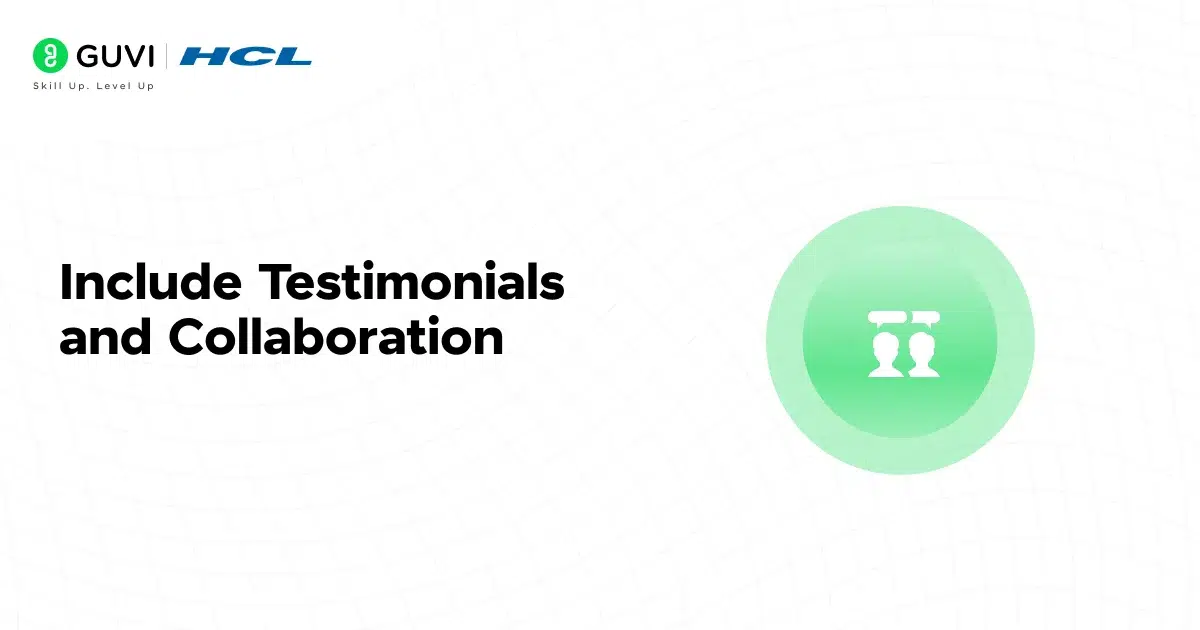
Sometimes the best proof of your abilities comes from others. Incorporating testimonials or examples of collaboration in your portfolio can boost your credibility.
If you have any positive feedback from previous employers, clients, professors, or colleagues, consider adding a short testimonial. A sentence or two quoting their praise (with permission) can go a long way.
Such testimonials serve as endorsements and can enhance your portfolio’s appeal by vouching for your expertise and work ethic.
Also highlight collaborative projects to show you thrive in team settings. If you worked on a group project or an open-source contribution, include it and clarify your role. This shows you can communicate and collaborate effectively.
For example, you might say, “Developed the front-end in a team of 4, coordinating closely with backend developers,” or “Contributed to an open-source library by adding X feature (merge request link).” Emphasize what you did and how you worked with others.
5. Use Multimedia to Showcase Your Work
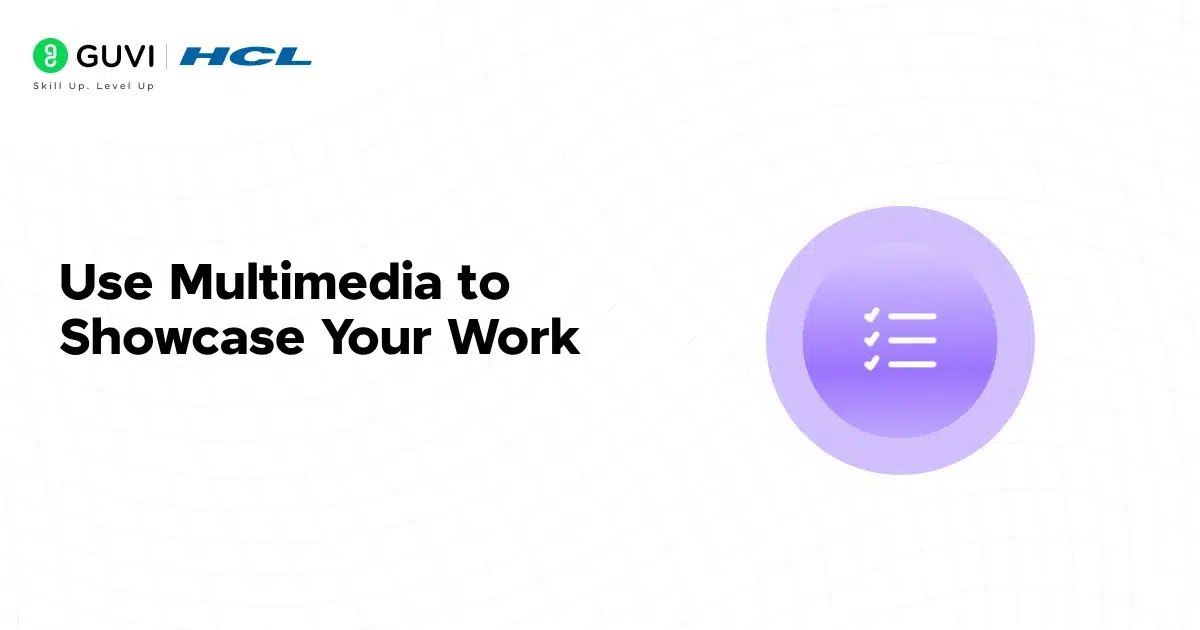
“Show, don’t tell” – it’s a cliché, but it holds true for technical portfolios. Along with written descriptions, visual and interactive elements can dramatically enhance how you showcase your technical skills. A dynamic, visually engaging portfolio will keep visitors interested and help them grasp your work at a glance.
Consider enriching your portfolio with:
- Screenshots: Show the user interface or important visuals from your projects (e.g., a dashboard you built or a before-and-after UI design). This instantly communicates what your project looks like and the design or data visualization skills involved.
- Live Demos/Videos: Embed a short video or GIF of your project in action. For a web app or game, a quick demo can convey the user experience far better than text. If a live version is available online, provide a link so people can try it out.
- Diagrams: Include a simple architecture diagram or infographic to explain complex systems or workflows. For example, a flowchart of your deployment process or a diagram of how different modules of your app interact. This illustrates your ability to design and think systematically.
Using such media isn’t just for flashiness, it actually demonstrates that you can communicate technical information effectively. It caters to visual learners and makes your portfolio memorable. Studies suggest that a visually rich portfolio with screenshots or demos leaves a lasting impression on potential employers, which could be the difference in them remembering you.
6. Share Your Learning Journey (Keep It Current)

A great portfolio not only shows what you have done, but also indicates that you are continuously learning and growing. Including a blog or otherwise sharing your learning journey can demonstrate your passion for technology and commitment to staying up-to-date in the field.
For newcomers, this might mean writing short articles or posts about projects you’re working on or new concepts you’re mastering. For seasoned professionals, it could involve publishing insights on industry trends, tutorials, or lessons from recent challenges. In either case, the act of writing about technical topics shows that you can reflect on and articulate what you learn.
Why is this valuable? First, it reinforces your expertise. Teaching or explaining something is a great way to prove you understand it deeply. Second, it shows continuous learning. In a fast-moving industry, employers love to see that you’re proactively keeping your skills fresh.
For example, if you’ve blogged about experimenting with a new JavaScript framework or analyzing a recent cybersecurity incident, it signals that you stay current beyond your formal work.
Additionally, creating content (whether blog posts, how-to guides, or even short LinkedIn articles) highlights your communication skills. It tells a recruiter that you can convey technical ideas clearly – an important asset when working in teams or explaining work to non-technical stakeholders.
You don’t have to be a prolific blogger, even occasional updates help. The key is that your portfolio feels “alive” and not stuck in the past.
Conclusion:
In conclusion, the work doesn’t end once you’ve put your portfolio together. Think of your portfolio as a living document that should evolve with your career. As you gain new experience, learn new skills, or complete new projects, update your portfolio accordingly.
Regularly adding (and sometimes pruning) content will ensure that what people see is an accurate and current reflection of your abilities.
A portfolio is your digital calling card to the professional world. So invest the effort to make it shine. With a clear, engaging, and ever-evolving portfolio, you’ll not only catch the eye of recruiters and clients but also give them confidence that you have the technical chops (and the professional savvy) to back it up. Good luck, and happy portfolio building!
FAQs
A clear structure helps viewers navigate your portfolio easily, ensuring they find relevant information quickly without being overwhelmed.
Yes, group projects are great for showing your ability to collaborate effectively. Just be sure to clearly describe your specific role and contributions.
Select testimonials that are relevant to your technical skills and from individuals who have directly worked with you and can vouch for your contributions and work quality.
Yes, personal projects often show personal initiative and can be very relevant, especially if they demonstrate important skills or a passion for your field.































Did you enjoy this article?